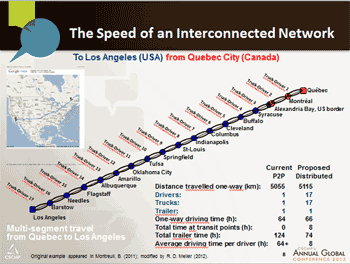|
We've been at it with some pretty hard core supply chain stuff over the past few weeks, with a series of "trip reports," conference video summaries and more. Back at the office for a full week I am going to lighten it up just a little here with a very interesting vision for the supply chain's future.
I know of it only because I stumbled into a session last October at the CSCMP conference in Atlanta, during a time slot when I didn't find any very compelling topics on the agenda. So I decided to take a chance on something called the "physical internet," and which turned out to be quite fascinating after all. I briefly summarized it in my CSCMP review, and promised more soon. Not sure if nine months later counts as soon, but here it is this week.
The supply chain research here is being performed under the auspices of the Center for Excellence in Logistics and Distribution, a consortium of sorts that combines a number of universities, some 30 sponsor organizations across business, the military and government agencies, and the National Sciences Foundation.
Gilmore Says: |
 The research found that a dedicated truckload moving from Quebec to Los Angeles would require a total transit time of 124 hours. Using the relay method, and an amazing 17 trucks, that time would be reduced to just 74 hours. The research found that a dedicated truckload moving from Quebec to Los Angeles would require a total transit time of 124 hours. Using the relay method, and an amazing 17 trucks, that time would be reduced to just 74 hours.

Click Here to See
Reader Feedback |
For this specific physical internet project, the Center received a grant from the NSF and sponsorship from a number of companies, including Walmart, Walgreen's, Procter & Gamble, RedPrairie (now JDA), JB Hunt, Boeing and more.
The final phase I report was written by Russell Meller of the University of Arkansas, Kimberly Ellis of Virginia Tech and Bill Loftis of Tompkins International (I've known Loftis for a long while). The document is long and a little tough to wade through, but as opposed to some academic research it is clear the authors understand how logistics really works. And as we frequently do, I hope to summarize that full document in a way that makes sense here.
I will say it this way: the goal of the physical internet initiative is to improve logistics performance in terms costs and service. It believes this can be done by improving "horizontal" collaboration - that is, collaboration across players in the same echelon of the supply chain - perhaps competitors - by in part sharing logistics/transportation resources. At the same time, such an approach can also go a long way to meeting the Global Logistics Sustainability Grand Challenge, the title of an academic article in 2011 that also talks about the physical internet.
Now, the potential for logistics collaboration is nothing new. The concept and potential benefits have been well understood for years. Anecdotally, the level of such collaboration has recently seemed to have increased, driven primarily by Green imperatives. But, there are barriers, and the practice is still minimal. What this research is trying to do is to better quantify a wide ranges of benefits from such collaboration, and then take the idea even further by some fairly radical concepts around how to better modularize and integrate the supply chain.
That is where the "internet" part of the thinking comes. The internet works with amazing speed and efficiency because of modularization and standardization. Information to be transmitted is nicely organized into small packets. A protocol (TCP/IP) understands those packets, and the collective network in turn understands how to route those packets based on the destination (IP address).
So, could that same concept work for physical logistics items as well, such as a pallet? Yes, the report says. I will come back to that in a second.
The report notes the many issues and opportunities. Thinking from a dedicated network perspective, as nearly every shipper does, inherently means you are stuck in some kind of a trade-off curve between cost and service, as you will find in most supply chain textbooks. In addition, we still are in general not using many of our logistics assets very effectively. The project's research indicates that in total truck trailers operate at only about a 50% utilization rate, when you combine the percent of trailers that are not maxed out in terms of weight and cube with the percent of deadhead miles (about 15%).
The report asks: "Why not transform our transportation system to allow us to fully utilize our logistics resources? Such a system would have significant economic, environmental and social implications."
So again this part of the concept is not really new. It involves shippers not having dedicated logistics all the way to the final customer, but rather shipping to an intermediate facility in local markets, which would in term ship freight from multiple companies to the final destinations.
Now, there is such a pilot going on in the consumer goods industry right now in Europe. In the US, we have the ES3 facilities that are essentially performing this role, maybe others. In the mid-1990s, Hau Lee of Stanford and others had the concept of Non-Stop Logistics, where consumer goods manufacturers would ship to a facility in local market, which would then distribute to meet local retail demand, though the focus there was more on inventory rather than transportation (the idea may have been ahead of its time).
But next is where the research brings some new thinking.
One goal, the report says, is to reduce the economic order quantity from a truckload, which it generally is today, to just a single pallet.
By having intermediate facilities closer to customers, and lower EOQ ordering thresholds, normal demand will become more stable (promotional demand may still move directly from manufacturer to retail DC), meaning the Bullwhip Effect will be tamed. This will help negate the additional inventory that would normally be associated with having more local stocking locations.
Additionally, the reduced variability would enable more shippers to use intermodal (rail) service to those local markets, which will reduce transportation costs and reduce greenhouse gas emissions.
Now here is where the thinking goes really out of the box. Even for long haul moves by truck, the idea is that rather than a single driver and truck, the goods would be moved by a series of short relays, as shown in the graphic below.

See Full Size Image
When I first saw this, my initial reaction was "the cost of all this handling and trucks would be huge."
But perhaps not so. Given Hours of Service and other constrains, the research found that a dedicated truckload moving from Quebec to Los Angeles would require a total transit time of 124 hours. Using the relay method, and an amazing 17 trucks, that time would be reduced to just 74 hours - two full days faster.
And guess what happens as truckload freight transportation moves to shorter hauls? Drivers get home most nights. Quality of life improves. And the permanent problem of drivers shortages in the industry gets dramatically better.
So how could such networks possibly transfer all that freight efficiently? Ah, back to the internet parallel. The industry must adopt standardize containers and platforms, as shown in the graphic here. That would mean carriers/3PLs could plan and optimize handling and loads consistently, well in advance, without worrying what was inside or how a given shipper builds it pallets or sizes its cartons. And by the way, these containers will also be smart.
Those containers would then be routed through the networks just like internet packets are, based on their final destination (just as they are say in the UPS network today). And carriers/3PLs would bid on moving those containers as a "black box" over the web. Put those last couple of concepts together, and you have the physical supply chain internet.
I am almost out of space and not finished, so I promise to revisit this soon.
The report containers several business cases done based on modeling of real data from shippers, carriers, and retailers. There is one each for consumer goods, retail, carriers/3PLs, and general manufacturing (yes, you were not left out).
So here is what the modeling says for consumer goods manufacturers: lead times drop from 2.5 days to one day; fill rates rise from 94% to 99%; on-time delivery improves from 92% to 98%; costs per mile drop from $1.82 to $1.62… You get the idea.
Interesting for sure, but can any of this really happen? We'll have to save that for next time. Would love to hear your opinion.
What is your reaction to the physical internet vision? Real promise, or pipe dream? What more would you like to know? Let us know your thoughts at the Feedback button (email) or section (web form) below.

|